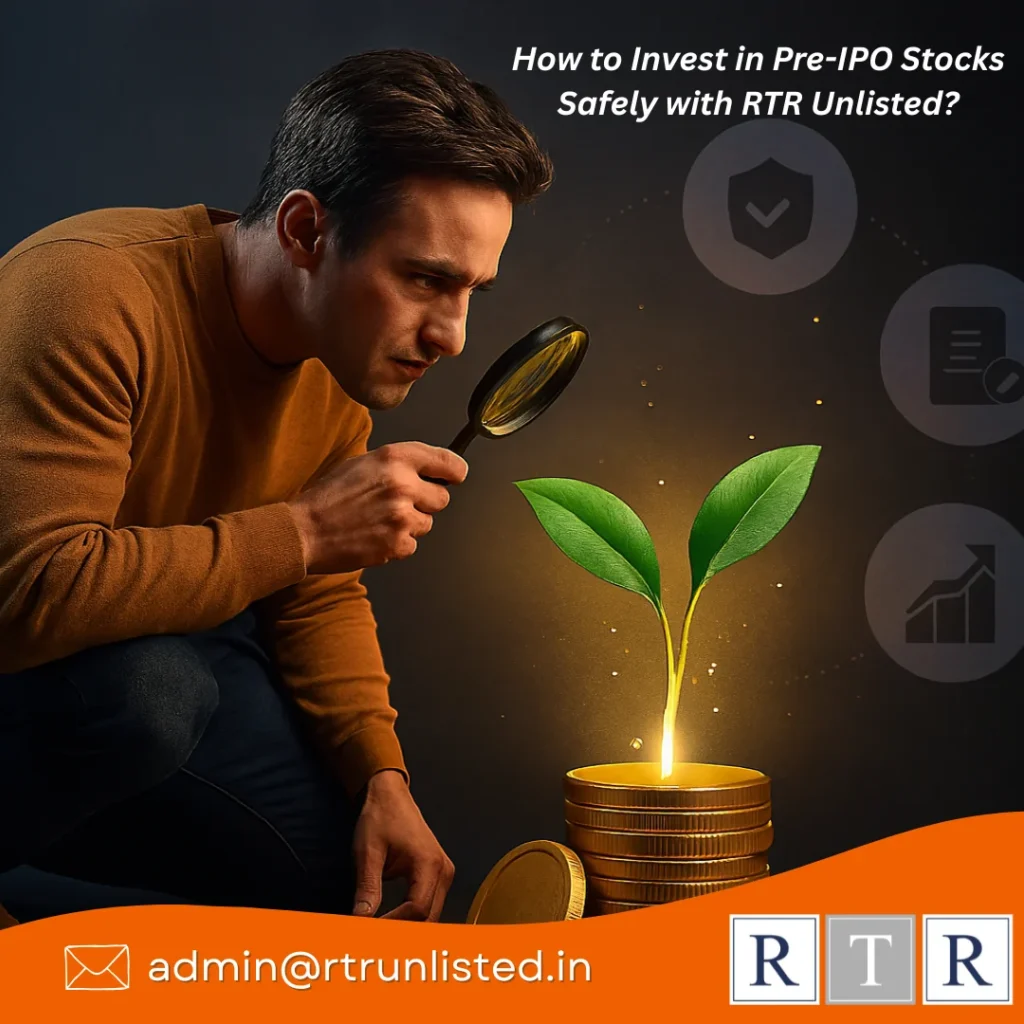
Pre-IPO (unlisted) shares let you own a piece of companies before they list on exchanges potentially large upside if the company performs well after IPO. But these opportunities come with higher information asymmetry, lower liquidity, and regulatory complexity than public markets. Use the right process, platforms, and risk controls to tilt the odds in your favour. (Background on pre-IPO mechanics and why retail interest has surged.)
What is RTR Unlisted?
RTR Unlisted positions itself as a trusted Indian platform connecting investors to unlisted and pre-IPO companies, offering discovery, pricing, and support for buying/selling unlisted shares. If you plan to use RTR Unlisted, confirm their latest terms, fees, address, and KYC/AML process directly on their site.
1. Start with the regulatory reality (don’t skip this)
India’s market regulator (SEBI) has repeatedly warned investors about trading through unauthorized platforms for unlisted securities — some websites operate without proper recognition and can expose retail investors to scams or non-compliant deals. Always verify platform legitimacy and whether the offering is permitted under current regulations.
2. Step-by-step process: How to invest safely (practical checklist)
Step A — Choose a reputable platform
Pick platforms that:
-
Publish clear contact details, company registration, and grievance process.
-
Perform seller verification and basic due diligence on listed opportunities.
RTR Unlisted is one such platform to evaluate — but do cross-check independently.
Step B — Do independent due diligence on the company
Ask for and review:
-
Latest audited financial statements (last 2–3 years) — balance sheet, P&L, cash flows.
-
Cap table and class of shares (are you buying ordinary shares, ESOPs, convertible notes?).
-
Board & management background, major customers, contracts, pending regulatory or litigation issues.
-
Recent valuations and last transaction price for the same share class. (Tools and pre-IPO guides suggest rigor here.)
Step C — Understand how you’re buying (mechanics & documentation)
-
Confirm whether you’re buying from an existing shareholder (secondary sale) or subscribing to a new issue.
-
Get clear transfer documents, share certificates (or demat instructions where applicable), and executed share transfer agreement.
-
Ensure payment routes are transparent (bank transfers to escrow/trust accounts rather than personal accounts). Platforms typically outline the process verify and retain all records.
Step D — Check liquidity, lock-ups, and exit routes
-
Many pre-IPO shares have lock-up periods or no guaranteed listing. Expect long holding periods and limited ability to sell before IPO. Read the shareholder agreement for transfer restrictions or right of first refusal (ROFR). Understand tax implications on sale.
Step E — Negotiate protections & terms (where possible)
-
Price per share, warranties, indemnities, representations, and any tag/drag rights matter. If buying ESOPs or employee shares, confirm exercise terms and whether taxes on exercise are your responsibility.
Step F — Small position sizing + portfolio rules
-
Limit exposure: treat pre-IPO as high-risk allocation (e.g., single-digit % of investable portfolio). Use position sizing, diversification across sectors, and ready cash for eventual taxes/holding costs.
3. Due diligence checklist (printable)
-
Company name, CIN (India), registered address.
-
Audited financials (2–3 yrs), management commentary, projections.
-
Latest cap table & list of existing investors.
-
Last transaction & valuation methodology.
-
Type of instrument (ordinary, preference, ESOP, convertible).
-
Transfer documents, escrow/earnest money terms.
-
Lock-up, ROFR, tag/drag clauses.
-
Tax treatment & likely exit scenarios.
-
Platform credentials, contact person, grievance resolution.
(Use this checklist before wiring money.)
4. Key risks (and how to mitigate them)
-
Liquidity risk: You may not be able to sell until IPO or find a buyer. Mitigate: expect long holding periods and keep allocation small.
-
Information gap: Private firms disclose less than public ones. Mitigate: demand audited statements, insist on management calls, and cross-verify claims.
-
Valuation uncertainty: Unlisted valuations are subjective. Mitigate: focus on fundamentals and realistic exit multiples; compare last transaction price to revenue/EBITDA.
-
Regulatory/platform risk: Some marketplaces operate without authorization. Mitigate: verify platform credentials and watch regulator alerts.
5. Tax & compliance basics (India)
Tax treatment varies by holding period and instrument type. Gains on sale of unlisted shares are usually taxed as capital gains; short-term vs long-term rules and applicable rates depend on how long you held the shares and specific provisions. Consult a tax advisor for your situation and keep all documents to substantiate cost basis and holding periods. (Always confirm with a local CA because tax law changes.)
6. Why use a vetted platform like RTR Unlisted and what to verify?
Platforms can:
-
Provide discovery and price transparency.
-
Channel escrowed payments and standard documentation.
-
Offer basic vetting and post-trade support.
But: platforms are intermediaries — you must still perform independent due diligence, read documents, and confirm KYC/AML procedures. Before committing, verify platform address, team, fee schedule, and any complaints or regulatory notices.
7. Practical example: a safe investor checklist before clicking “Buy”
-
Platform: Confirm registration, contact, and grievance process.
-
Documents: Audited financials, cap table, transfer deed, seller identity.
-
Valuation: Understand last transaction price & what you’re paying relative to revenues/EBITDA.
-
Exit plan: Is the company actively preparing for an IPO? Any timelines or binding commitments?
-
Payment: Use escrow; get receipts and executed transfer agreements.
-
Size: Keep exposure as per your risk profile and smaller allocation compared to over all portfolio
8. Common FAQs
Q: Are pre-IPO stocks suitable for retail investors?
A: They can be, but only for those who accept high risk, illiquidity, and the need for deep due diligence. Keep small allocations and diversify.
Q: Can pre-IPO investments be scams?
A: Yes — especially on unauthorized platforms. Check regulator alerts and avoid transfers to private accounts without clear documentation.
Q: When will I likely get liquidity?
A: Usually at IPO, a secondary sale, or buybacks — timelines vary and Remover may take years. Expect limited short-term liquidity.
Conclusion
Pre-IPO investing can be rewarding, but success depends on discipline: pick reputable platforms (verify them), perform exhaustive due diligence, limit position size, and prepare for long holding periods and regulatory complexity. Platforms such as RTR Unlisted can help you discover opportunities but treat them as tools, not replacements for your own verification and risk controls.
To stay ahead, visit rtrunlisted.com — your trusted partner for verified unlisted share pricing, latest updates, and long-term investment insights.
Sources & further reading (important)
-
RTR Unlisted — home & contact pages (platform details). RTR Unlisted+1
-
SEBI/regulatory warnings about unauthorised unlisted trading platforms (Reuters coverage). Reuters
-
Groww — guide on how pre-IPO investing works and mechanics. Groww
-
UpMarket — practical pre-IPO investment checklist and secondaries guide. AltInvests
-
Investopedia — explanation of lock-up periods and liquidity considerations. Investopedia
Mail us :- admin@rtrunlised.in
To Read More Blogs:- Click Here
